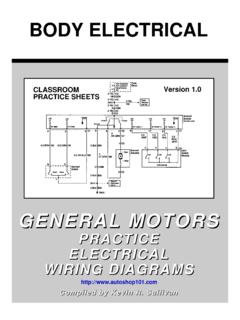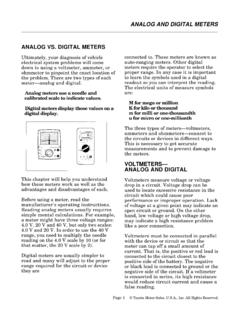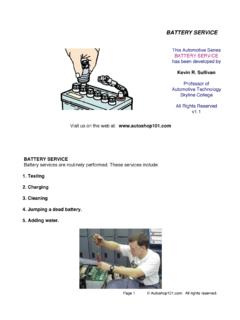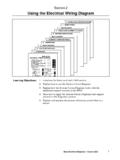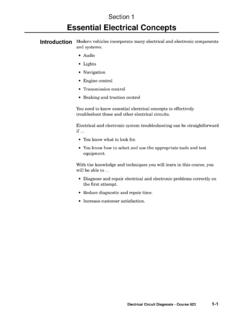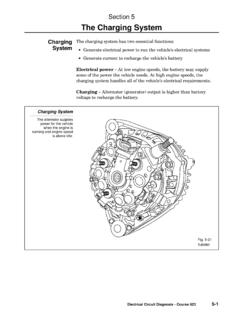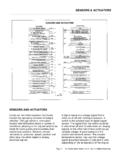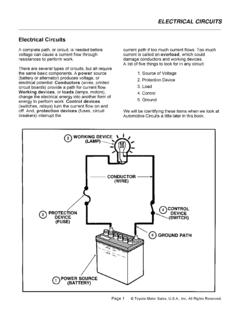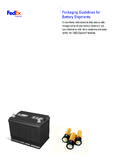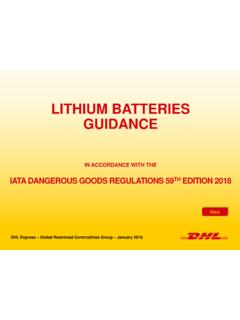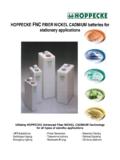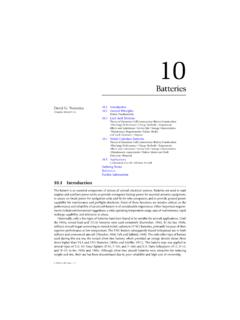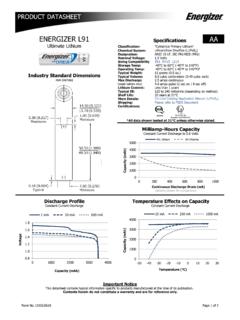Transcription of General Battery Types - Autoshop 101
1 GeneralThe Battery is the primary "source" of electrical energy on Toyota vehicles. It stores chemicals, not electricity. Two different Types of lead in an acid mixture react to produce an electrical pressure. This electrochemical reaction changes chemical energy to electrical energy. Battery Functions1. ENGINE OFF: Battery energy is used to operate the lighting and accessory systems. 2. ENGINE STARTING: Battery energy is used to operate the starter motor and to provide current for the ignition system during cranking. 3. ENGINE RUNNING: Battery energy may be needed when the vehicle's electrical load requirements exceed the supply from the charging system. In addition, the Battery also serves as a voltage stabilizer, or large filter, by absorbing abnormal, transient voltages in the vehicle's electrical system.
2 Without this protection, certain electrical or electronic components could be damaged by these high voltages. Battery Types1. PRIMARY CELL: The chemical reaction totally destroys one of the metals after a period of time. Small batteries for flashlights and radios are primary cells. 2. SECONDARY CELLS: The metals and acid mixture change as the Battery supplies voltage. The metals become similar, the acid strength weakens. This is called discharging. By applying current to the Battery in the opposite direction, the Battery materials can be restored. This is called charging. Automotive lead-acid batteries are secondary cells. 3. WET-CHARGED: The lead-acid Battery is filled with electrolyte and charged when it is built. During storage, a slow chemical reaction will cause self-discharge. Periodic charging is required.
3 For Toyota batteries, this is every 5 to 7 months. 4. DRY-CHARGED: The Battery is built, charged, washed and dried, sealed, and shipped without electrolyte. It can be stored for 12 to .18 months. When put into use, it requires adding electrolyte and charging. 5. LOW-MAINTENANCE: Most batteries for Toyota vehicles are considered low-maintenance batteries. Such batteries are built to reduce internal heat and water loss. The addition of water should only be required every 15,000 miles or so. BATTERIES Page 1 Toyota Motor Sales, , Inc. All Rights Reserved. Construction1. CASE: Container which holds and protects all Battery components and electrolyte, separates cells, and provides space at the bottom for sediment (active materials washed off plates).
4 Translucent plastic cases allow checking electrolyte level without removing vent caps. 2. COVER: Permanently sealed to the top of the case; provides outlets for terminal posts, vent holes for venting of gases and for Battery maintenance (checking electrolyte, adding water). 3. PLATES: Positive and negative plates have a grid framework of antimony and lead alloy. Active material is pasted to the grid .. brown-colored lead dioxide (Pb02) on positive plates, gray-colored sponge lead (Pb) on negative plates. The number and size of the plates determine current capability .. batteries with large plates or many plates produce more current than batteries with small plates or few plates. 4. SEPARATORS: Thin, porous insulators (woven glass or plastic envelopes) are placed between positive and negative plates.
5 They allow passage of electrolyte, yet prevent the plates from touching and shorting out. 5. CELLS: An assembly of connected positive and negative plates with separators in between is called a cell or element. When immersed in electrolyte, a cell produces about volts (regardless of the number or size of plates). Battery cells are connected in series, so the number of cells determines the Battery voltage. A "1 2 - volt" Battery has six cells. 6. CELL CONNECTORS: Heavy, cast alloy metal straps are welded to the negative terminal of one cell and the positive terminal of the adjoining cell until all six cells are connected in series. 7. CELL PARTITIONS: Part of the case, the partitions separate each cell. 8. TERMINAL POSTS: Positive and negative posts (terminals) on the case top have thick, heavy cables connected to them.
6 These cables connect the Battery to the vehicle's electrical system (positive) and to ground (negative). 9. VENT CAPS: Types include individual filler plugs, strip-type, or box-type. They allow controlled release of hydrogen gas during charging (vehicle operation). Removed, they permit checking electrolyte and, if necessary, adding water. 10. ELECTROLYTE: A mixture of sulfuric acid (H2SO4) and water (H2O). It reacts chemically with the active materials in the plates to create an electrical pressure (voltage). And, it conducts the electrical current produced by that pressure from plate to plate. A fully charged Battery will have about 36% acid and 64% water. BATTERIES Page 2 Toyota Motor Sales, , Inc.
7 All Rights Reserved. CELL THEORYA lead-acid cell works by a simple principle: when two different metals are immersed in an acid solution, a chemical reaction creates an electrical metal is brown-colored lead dioxide (Pb02). It has a positive electrical charge. The other metal is gray colored sponge lead (Pb). It has a negative electrical charge. The acid solution is a mixture of sulfuric acid (H2SO4) and water (H20). It is called a conductor and a load are connected between the two metals, current will flow. This discharging will continue until the metals become alike and the acid is used up. The action can be reversed by sending current into the cell in the opposite direction. This charging will continue until the cell materials are restored to their original Page 3 Toyota Motor Sales, , Inc.
8 All Rights Reserved. ELECTROCHEMICAL REACTIONA lead-acid storage Battery can be partially discharged and recharged many times. There are four stages in this discharging/charging CHARGED: A fully charged Battery contains a negative plate of sponge lead (Pb), a positive plate of lead dioxide (Pb02), and electrolyte of sulfuric acid (H2SO4) and water (H20).2. DISCHARGING: As the Battery is discharging, the electrolyte becomes diluted and the plates become sulfated. The electrolyte divides into hydrogen (H2) and sulfate(S04) . The hydrogen (H2) combines with oxygen (0) from the positive plate to form more water (H20). The sulfate combines with the lead (Pb) in both plates to form lead sulfate (PbS04)3. DISCHARGED: In a fully discharged Battery , both plates are covered with lead sulfate (PbSO4) and the electrolyte is diluted to mostly water (H2O).
9 4. CHARGING: During charging, the chemical action is reversed. Sulfate (S04) leaves the plates and combines with hydrogen (H2) to become sulfuric acid (H2SO4). Free oxygen (02) combines with lead (Pb) on the positive plate to form lead dioxide (Pb02). Gassing occurs as the Battery nears full charge, and hydrogen bubbles out at the negative plates, oxygen at the Page 4 Toyota Motor Sales, , Inc. All Rights Reserved. Capacity RatingsThe Battery must be capable of cranking the engine and providing adequate reserve capacity. Its capacity is the amount of electrical energy the Battery can deliver when fully charged. Capacity is determined by the size and number of plates, the number of cells, and the strength and volume of most commonly used ratings are: Cold Cranking Amperes (CCA) Reserve Capacity (RC) Amp-Hours (AH) Power (Watts)COLD-CRANKING AMPERES (CCA)The Battery 's primary function is to provide energy to crank the engine during starting.
10 This requires a large discharge in a short time. The CCA Rating specifies, in amperes, the discharge load a fully charged Battery at 0 F (-1 C) can deliver for 30 seconds while maintaining a voltage of at least volts per cell ( volts total for a 12-volt Battery ). Batteries used on various Toyota vehicles have CCA ratings ranging from 350 to 560 CAPACITY (RC)The Battery must provide emergency energy for ignition, lights, and accessories if the vehicle's charging system fails. This requires adequate capacity at normal temperatures for a certain amount of time. The RC Rating specifies, in minutes, the length of time a fully charged Battery at 80 F ( 'C) can be discharged at 25 amps while maintaining a voltage of at least volts per cell ( volts total for a 12-volt Battery ). Batteries used on various Toyota vehicles have RC ratings ranging from 55 to 115 minutes.
